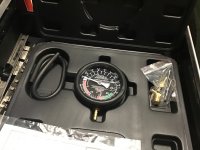Federalees
Freshman Member
Offline
Hello!
I am new to this forum and wanted to make my introductory post. I recently acquired a 1967 TR4A IRS and this forum has been a wealth of information. Thank you for that! In this post I figured I would relate a problem that I resolved that seems pretty common based on other posts that I have searched. However, the resolution to the problem was one that I had not seen.
I recently smelled gas in then garage and noticed fuel seeping from the fuel pump, so i decided to rebuild it. Easy enough, but once I reinstalled the pump and started the car, I noticed a lot of gas weeping from the vent hole of the back carburettor. Assuming that this was the actual cause of the gas smell and I hadn't notice it before, I checked floats on both carbs for adjustment and leaking but they were fine. I replaced the needle and seats on both carbs along with the floats for good measure and none of this solved the problem. This was driving me a bit bonkers. I spoke to everyone I could find that was an expert on SU HS6 and searched this forum for the answer but was unsuccessful. So, back troubleshooting 101. What changed? The only thing was the rebuilt fuel pump. I checked the pressure from the pump and it was at 7 PSI !! Instead of pulling it apart again, I replaced it with a new pump. Problem solved! (face palm). So now I am wondering what I did wrong in rebuilding the pump that would cause such high pressure. Any ideas? Has anyone had this problem? The kit came with the diaphragm gaskets, and check valves, which I have double checked and they are installed properly as far as I can tell.
I am new to this forum and wanted to make my introductory post. I recently acquired a 1967 TR4A IRS and this forum has been a wealth of information. Thank you for that! In this post I figured I would relate a problem that I resolved that seems pretty common based on other posts that I have searched. However, the resolution to the problem was one that I had not seen.
I recently smelled gas in then garage and noticed fuel seeping from the fuel pump, so i decided to rebuild it. Easy enough, but once I reinstalled the pump and started the car, I noticed a lot of gas weeping from the vent hole of the back carburettor. Assuming that this was the actual cause of the gas smell and I hadn't notice it before, I checked floats on both carbs for adjustment and leaking but they were fine. I replaced the needle and seats on both carbs along with the floats for good measure and none of this solved the problem. This was driving me a bit bonkers. I spoke to everyone I could find that was an expert on SU HS6 and searched this forum for the answer but was unsuccessful. So, back troubleshooting 101. What changed? The only thing was the rebuilt fuel pump. I checked the pressure from the pump and it was at 7 PSI !! Instead of pulling it apart again, I replaced it with a new pump. Problem solved! (face palm). So now I am wondering what I did wrong in rebuilding the pump that would cause such high pressure. Any ideas? Has anyone had this problem? The kit came with the diaphragm gaskets, and check valves, which I have double checked and they are installed properly as far as I can tell.

 Hi Guest!
Hi Guest!

 smilie in place of the real @
smilie in place of the real @
 Pretty Please - add it to our Events forum(s) and add to the calendar! >>
Pretty Please - add it to our Events forum(s) and add to the calendar! >> 


